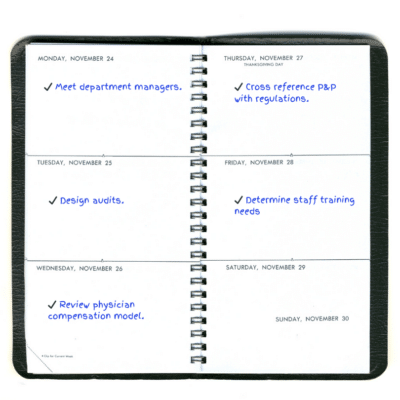This is Part 1 of a two-part series on compliance officers and compliance committees in a healthcare setting. In this part, we discuss how a new compliance officer should undertake his or her new responsibilities. In Part 2, we will cover the role and responsibilities of a Compliance Committee.
In this Article …
The Diverse Challenges Faced by New Healthcare Compliance Officers
A new compliance officer could be coming into many types of situations. Some depend on the qualifications and experience of the compliance officer. Is this the first time the person is undertaking the compliance officer role? Or is this an experienced person taking on the role of Chief Compliance Officer in a larger organization?
Other situations depend on the history and experience of the organization with previous compliance officers. Was the compliance officer an asset to the organization and the Board? Or was he or she mistrusted by managers and staff, or overly rigid in leading the compliance functions of the business?
And still, other factors include the type of business and business goals of the company. A wide range of industry or business sectors have or need compliance programs. Many business sectors are subject to rules or regulations requiring a compliance and ethics program. Other organizations, especially in healthcare, have no law or regulation requiring compliance officers, but some do have government regulatory guidance on a compliance program.
For our purposes in this discussion, we will assume the situation of a new compliance officer in a new position at a healthcare organization that has not previously had a corporate compliance program. What are the priorities on the first day, the first week, and during the first month?
New Compliance Officers on the 1st Day
The first day on the job for anyone in a new role at a healthcare organization that has not had a person in that role previously is bound to be at least a little overwhelming. You might have some idea of the expectations and resources from the hiring process. But now you are faced with meeting a 
- Review any regulatory guidance on compliance programs issued by the Office of Inspector General (OIG) of the Health and Human Services Department (HHS) for the business activities of your organization. There are at least two types of healthcare organizations that are required to comply with regulations to have compliance officers and compliance programs. These are skilled nursing facilities and accountable care organizations. Many other healthcare businesses have regulatory guidance on such programs.
- Make sure you understand the prospective role of the position of a Chief Compliance Officer and the relationships with other functions such as quality management and risk management. In many organizations, the compliance officer reports to the CEO. Most regulatory guidance advises compliance officers also to have a direct reporting relationship with the Board of Directors or other official governing bodies. Of course, there should be a job description, but all of the expectations and relationships usually extend beyond the text of the job description.
New Compliance Officers During the 1st Week
During the first week, you will want to spend more time getting familiar with other staff and managers in the company. You want to learn in more detail about their operations and how those functions may be influenced by implementing a compliance program.

When your organization is one of the 10 designated health services, there is another major risk area to learn about: compensation to physicians who also make referrals of patients whose services are billed to government healthcare programs. The Stark regulations prohibit compensation to physicians that is in any way related to the value or volume of these referrals. These rules also contain exceptions that must be met in order to avoid the penalties that can be imposed for violating them.
A fourth significant compliance risk area to check on during your first week is the OIG exclusion screening of staff members and training of staff members on corporate compliance. Employing an excluded individual in a role that contributes to patient care or is part of the billing processes presents significant risks to the organization. You want to be assured that there is an effective screening process in place.
Take a look at policies and processes that address other common risk areas of the company. These include processes like submitting claims for services to government healthcare programs like Medicare and Medicaid, medical necessity of services, and business arrangements that may violate the Anti-kickback Statute.
New Compliance Officers During the 1st Month
Now that you’ve had a week to understand several things about the organization and your new position, it’s time to begin looking at the next steps in implementing a compliance program. You should be familiar with the regulations or regulatory guidance on compliance programs for your type of organization. You should understand at least some of the organization’s compliance risks and the role of other managers and staff in mitigating those risks.

The first step is drafting policies and procedures for your compliance program. Here is where chief compliance officers can address all the regulations/regulator guidance that apply to your organization. For many healthcare businesses, the regulatory guidance on a compliance program is very similar. The basic compliance program policy should address:
- The commitment of the company to complying with all applicable laws and regulations, and avoiding fraud and abuse;
- The roles and responsibilities for overseeing and managing the compliance program;
- The risk areas of the business;
- Periodic staff training requirements;
- Effective lines of communication;
- Enforcing policies through disciplinary guidelines;
- Auditing and monitoring; and
- Responding to detected offenses.
A second major document of a compliance program is a Code of Conduct. These codes illustrate the organization’s commitment to ethical conduct and adherence to the healthcare services organization’s policies and procedures. Codes of conduct also describe the management’s commitment to integrity and excellence in the organization.
Another thing to accomplish in the first month is to organize and convene a Compliance Committee. The role of the compliance committee to to collaborate with chief compliance officers on the administration of the compliance program. We will discuss the roles and responsibilities of the Compliance Committee in Part 2 of this series.
Of course, there are many other activities new compliance officers must lead or participate in as the months go by. And along the way you may find the need for more resources to ensure the existence of an effective compliance program. This post is really just scratching the surface, so don’t hesitate to seek help and guidance as needed!
The Road Ahead Leads to a Seasoned Chief Compliance Officer
Embarking on the journey of a new compliance officer in a healthcare setting is akin to navigating through uncharted territories, where every step is a learning opportunity and every challenge a chance for growth. The initial days may be filled with a whirlwind of activities, from understanding regulatory guidelines to fostering relationships with various stakeholders. However, as the days turn into weeks and months, a seasoned Chief Compliance Officer should begin to emerge, adept at managing the complexities of the healthcare compliance landscape.
As your journey continues, be aware of two factors that can affect you – among many others. The first is your growth as a compliance professional. Anyone thinking about a career in corporate compliance should seriously consider attaining certification as a compliance professional. Organizations such as the Health Care Compliance Association can provide education opportunities as well as certification programs.
The second factor to consider is the pressure that may come as you are faced with recommending against various strategies that are questionable from a compliance perspective. These could include things like pressure to offer physician compensation that is at or even above the upper limit of fair market value for the services. Or to approve business arrangements that may be viewed as kickbacks for patient referrals. Certainly compliance officers want to support the business goals of the organization, but you must avoid the temptation to go along with an arrangement that may leave the organization at risk just because other senior leaders are advocating it.
Ultimately, one of the goals of the compliance officer is to establish a culture of compliance. In this culture, staff members identify situations that don’t seem quite right, and report them! Middle managers and senior leadership support the efforts of the compliance officer and the Compliance Committee. And the Board comes to rely on reports from the compliance officer when there are investigations to be completed. A worthy goal indeed!
As the landscape of healthcare compliance continues to evolve, especially in the age of digital transformation, the need for an effective compliance program and strategic guidance becomes paramount. Embracing digital transformation not only streamlines processes but also enhances the efficiency and accuracy of compliance measures. Recognizing the value of external collaboration can be a game-changer in establishing and maintaining such a program. With the right partnerships, the benefits for the organization are substantial. Here’s to healthcare organizations championing compliance excellence in a dynamic industry!

